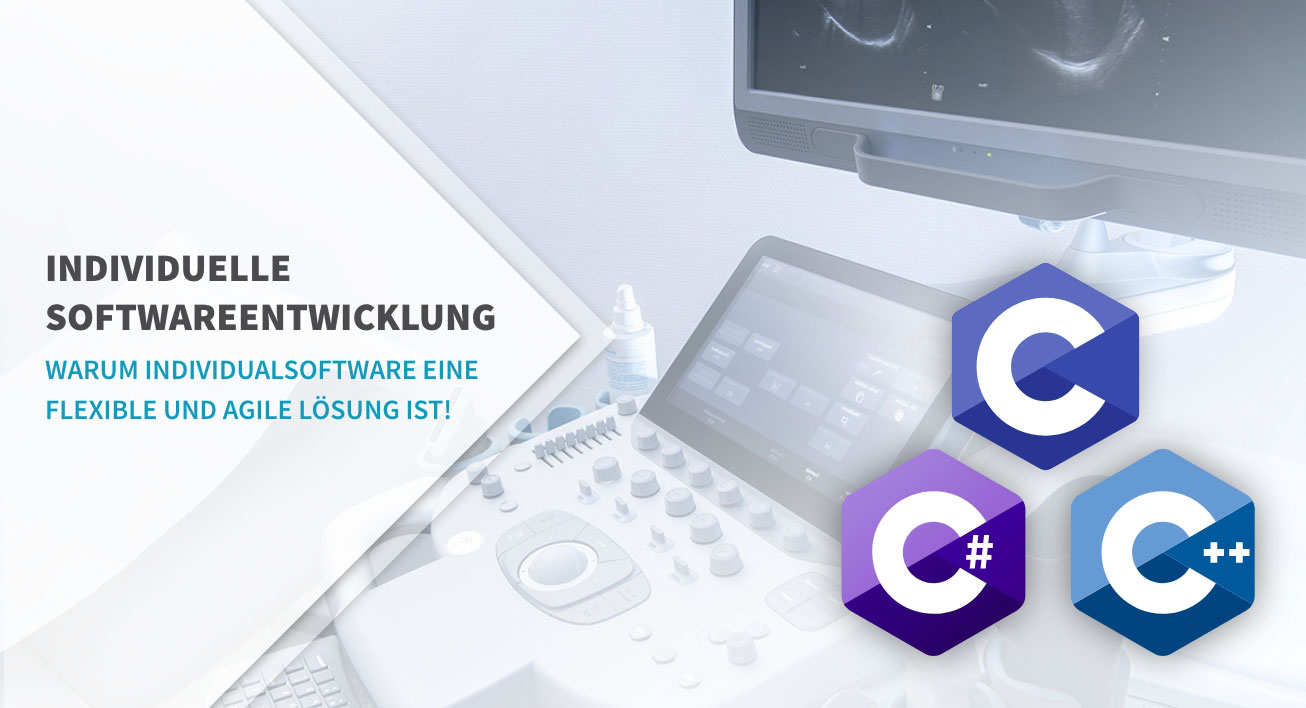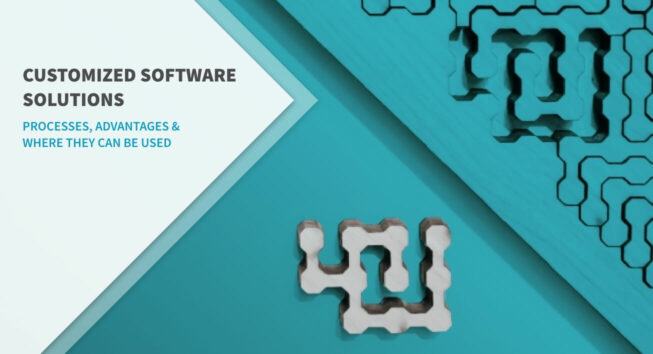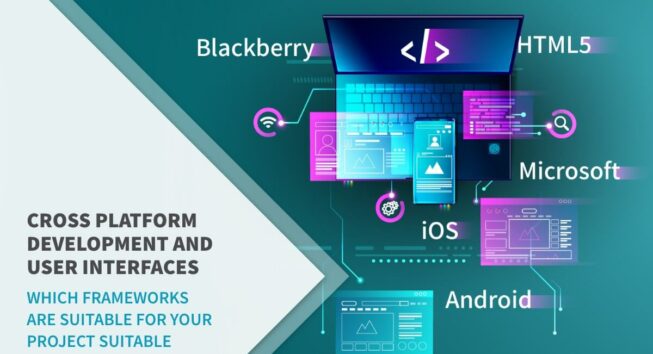
21. December 2023 von Vanessa Schröter
Software



WHY CUSTOM SOFTWARE IS A FLEXIBLE AND AGILE SOLUTION
published at 31.08.2022 from Tom Buschbeck
Flexible. Incremental. Agile. Lean. Customer-focused. Individual. Reliable. These attributes can all describe individual software development. What matters is the individuality, which is determined by the uniqueness of the customer project in every development. Therefore, each company should be treated according to its personal prerequisites and requirements. In this way, every software development is redesigned while still remaining efficient in its solutions. The goal should never be lost sight of. After all, the most important thing is that the new customised software is comprehensively convincing in the end and meets all the needs for your company.
In this article, you will learn which technologies and programming languages make up custom software development and how they are used, as well as which frameworks, tools and solutions are important for successful software development. In addition, we provide an insight into best practices and shed light on which forms of project management are efficient for companies.

Not every software project starts at 0 and ends at 100. Sometimes it is necessary to extend the development capacities externally in the middle, to obtain advice from specialists or to have another developer’s eye look over the finished software in order to fully exploit the last potentials.
Complex tasks include designing and developing advanced software architectures as well as maintaining, expanding and optimising application software (apps) and many other solutions:
In the software world there are now countless programming languages for processing data, many of which are similar, build on each other or there is the possibility of combining several languages. In the following, we will introduce you to the three most common programming languages. This is a summary of their most important features and areas of application:
A framework, as the name suggests, provides a framework structure for the individual software and contains various libraries and classification criteria that accelerate software development. Depending on the use case and the customer’s specifications, software developers use various modern web, app and test frameworks. Particularly for the development of software applications in C++, C# and Java, the technical support provided by a framework is useful, but they also represent a useful technology when programming embedded software (ARM, AVR, SPARC).

Qt: A framework that can map almost everything from database access, software logic to GUIs and enables platform-independent application development in C++ or QML.
Boost: Probably the best-known C++ library collection for portable software as well as for the operating systems macOS, Windows, Linux and others.
Microsoft.NET Framework (with WinForms, WPF, ASP.NET & .NET Core): C# development for all web, mobile and desktop applications, microservices, cloud services, IoT and more.
SPRING: Open source framework for web development with Java.
WE PRESENT A SELECTION OF MODERN TECHNOLOGIES THAT WE HAVE USED WITH OUR CUSTOMERS AND ACHIEVED GOOD RESULTS:
Internet of Things (IoT for short): Letting devices communicate with each other thanks to the right software – for example, using ZigBee, MQTT, RFID or Bluetooth – makes your company and your business smarter.
In the embedded software area, for example, technologies such as Qt for MCU, ARM processors and AVR microcontrollers, Arduino for developing prototypes and Raspberry Pi computers can be used.
Continuous Integration (CI): With CI, the individual components of the software application being developed are tested and merged directly and continuously during the process, resulting in higher quality. As a supporting tool for build automation, Jenkins, for example, is a good tool.
Git and Subversion: These version management tools and the programmes they contain can also be used to log, display and navigate non-linear histories of a software project with large development structures easily and efficiently. In addition, the two tools offer many more functions that make development much more productive.
Qt Bridge for Adobe Photoshop: Helps manage, edit, organise and share graphical material for user interfaces and facilitates collaboration between designers, front-end and back-end. With Qt Bridge, Photoshop files in XML format can be easily synthesised into C++ code by the Meta Object Compiler, so that the implementation in the frontend remains true to the original with Qt and can then be easily linked to in the backend.
If you compare individual software development with a journey, you can say that it is advantageous to speak many languages at the beginning. This way, you can safely reach your destination on a journey. It is also faster and more direct with a map that shows you the possible routes. If a car with an appropriate driving licence is also available, then the project will soon be achieved quickly and safely. This means: a software developer always needs good equipment to get the most out of what he has in him and to be at the forefront of the competition.
Good planning is the golden key to developing efficient software for businesses. Even though most programmers would prefer to start coding the software within the first minute of starting the job, and this approach may seem efficient at first – this way system gaps are predetermined. Within an individual software development, there are often changes and revisions throughout the project process. Conventional project management approaches are therefore too inflexible and ineffective, for example through rigid release processes. At the same time, unforeseen cost and time expenditures can be avoided in cooperation with customers. Therefore, agile project management should be used in the development and test departments and the individual needs of the customer should be addressed.
It should be possible to implement individual wishes flexibly and individually. It is particularly important that the project management model fits your company, the project, its status and the individual requirements. The procedure can be based on SCRUM as well as the Lean Startup model. These four stages provide the basic roadmap:

As with classical models, agile software development also plans in advance which budgets and timeframes are to be adhered to under the overall goal. Taking into account the specifics of the project as well as the software development approach, it is also planned which programming language and associated toolkits will be used to get the best out of your new software solution.
Visions and requirements can best be realised in small, concretely formulated stages. The team of software developers assembled for your project agrees in sprint planning to implement the user stories and intentions of the first development step, the so-called sprint, as defined by the product owner. In addition, the purpose of this sprint is defined so that each team member has an understanding of the upcoming work content and its individual solutions.
From now on, the first hot phase begins. The first lines of code are written, backlog items are implemented and daily or weekly updates are given. Different approaches to individual software development and quality assurance can take place. During the sprint, progress is accurately documented. The time frame of a sprint phase varies between one and four weeks, but remains the same within a project. Thanks to digital time recording, all participants always keep track of the current progress.
After completion of the first increment, it is presented, analysed and the methodical procedure is evaluated retrospectively. If certain potentials are discovered, direct improvement measures are planned for the next sprint phase and then the interim result is presented. If the customer is dissatisfied, the result is corrected in parallel to the following sprint or the focus is once again holistically on optimisation before moving on to the second, third and fourth sprint.
A project often evolves in its requirements and solutions. Most software agencies focus on agile methods and lean models in project management, as these allow for additional flexibility and bring more efficiency as well as productivity. For each project, a team of software developers is individually assembled with a product owner / project manager, as envisaged by the Scrum concept. This ensures that the project framework is adhered to and the value of the product to be developed is maximised.
Individual tasks are distributed to the responsible teams and self-organisation is promoted without management overhead. With Lean Management, the process remains as lean as possible to save time and costs and to invest 100% of the labour input in the development and optimisation of your required software functions and applications.
Agile project management also prioritises maximising your business value. Here, it is crucial to get into the programming of the individual software early, to involve the users strongly in the process and to test the software again and again on a regular basis. This requires the process to remain very flexible and individual in order to directly integrate and implement innovative ideas that arise during development, if necessary.

In the area of individual software development, igniti supports your company from the initial conception to the implementation of various projects – regardless of status and model – as a long-term software service provider with all the trimmings or relieving you as a support engineer.
Do not hesitate to contact us. Together we can achieve great things and develop the right software solution for you. The service you need is not mentioned on our website? Contact us anyway – we love challenges!

about the author
Tom Buschbeck
Tom hat an der Technischen Universität Ilmenau seinen Bachelor in Ingenieurinformatik absolviert, und praktische Erfahrungen in diversen Softwareunternehmen gesammelt, bevor er 2015 zur igniti kam und zunächst als Softwareentwickler für C++ den Bereich mit aufgebaut hat. Als Head of Digital Solutions kümmerte er sich bis 2023 um sämtliche Bereiche im Unternehmen, um diese weiter voran zu bringen.

21. December 2023 von Vanessa Schröter
Software
18. August 2022 von Tom Buschbeck
Software
28. June 2022 von Tom Buschbeck
SoftwareLet us start!